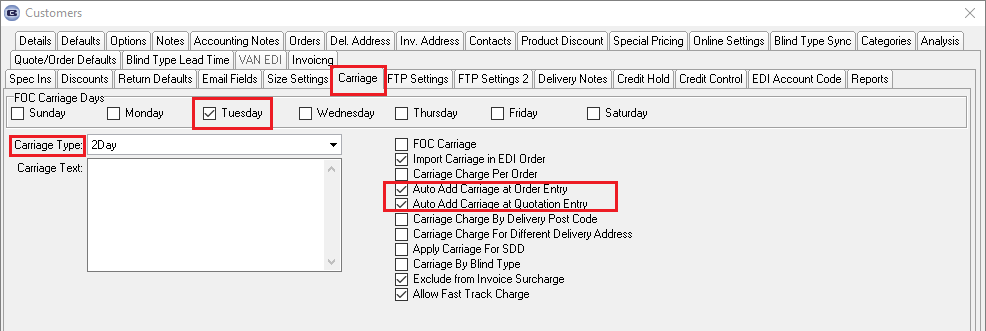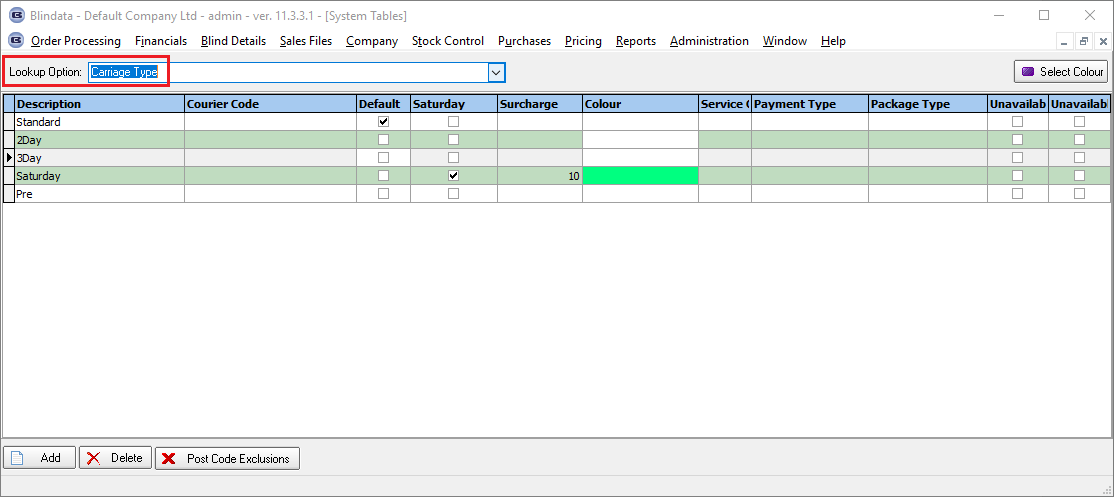Carriage¶
Step by Step Instruction - Carriage Surcharge
Step by Step Instruction - Carriage By Area and Total
Step by Step Instruction - Fast Track Charge
Step by Step Instruction - Invoice Surcharge


There is a field in the Customers table called ‘FOC Carriage’ - a ‘free of charge carriage’.
When we calculate the amount of carriage that must be applied to orders, the customers with FOC Carriage = true are not included.
There is now a ‘Carriage Override’ flag on the order entry form.
If this is flagged as true, then their carriage charge is applied to the order at the ‘Create Invoices’ stage.
If a customer has a default setting of ‘FOC Carriage’ = true, then the ‘Carriage Override’ is set to true when an order is created, otherwise, it defaults to false.
There is a new ‘Advanced Permission’ in Administration > Users > Advanced Permissions > Order to give a user permission to amend this field.
When you set the ‘Carriage Override’ button to true, it did not save it unless ‘FOC Carriage’ = true in the customer record.
It is now possible to save this, regardless of whether ‘FOC Carriage’ = true or false in the customer record.
Financials > Create Invoices
If a customer is set up with ‘Batch Invoice’ = true and ‘Carriage Charge Per Order’ = false and ‘FOC Carriage’ = false, when invoices are created, then if the total of the orders per invoice number is less than the carriage free amount, then carriage is only applied to the last order.
We now have a new option called ‘Carriage Surcharge’ so we can identify the difference between ‘Carriage’ and ‘Carriage Surcharge’.
We have also rearranged the carriage flags in the customer record.
‘FOC Carriage’, ‘Carriage Charge Per Order’ and ‘Auto Add Carriage at Order Entry’ should all be held together.
Carriage by Postcode
It is now possible to hold a carriage amount against a postcode.
This is picked up when the order is first saved. The carriage is related to the postcode that is held against the delivery address.
We have also carried out a full review of how the carriage works in the system.
There are now a lot of different ways of calculating carriage, and it has become complicated.
First of all, let’s distinguish between carriage that can be entered at order entry and carriage that is calculated at ‘Create Invoice’ stage.
This is currently determined by ‘Add Carriage at Order Entry’.
We also have two other fields in here – ‘FOC Carriage’ and ‘Carriage Charge Per Order' .
There is now a further flag called ‘Carriage Charge by Delivery Postcode’.
There is also a new field called ‘Delivery Address Carriage Charge’ which is held against the postcode record in System Tables > Postcodes.
We also need some way of updating all these to a particular amount and then changing some.
Maybe we could filter by postcode and have an updated amount with a button called ‘Update Selected Records’.
There is a new condition that if ‘FOC Carriage’ = true, then all the other carriage flags are set to false.
‘FOC’ means free of charge’ so if this is set carriage should never be charged to the customer.
If ‘Carriage Charge Per Order’ or ‘Add Carriage at Order Entry’ or ‘Carriage Charge by Delivery Postcode’ = true, then ‘FOC Carriage’ is set to false.
These changes are all recorded in history.
If ‘Carriage Charge By Delivery Postcode’ = true, then ‘Carriage Charge Per Order’ is set to true, and ‘Add Carriage at Order Entry’ is also set to true.
At the ‘Create Invoices’ stage, the carriage is only calculated if ‘FOC Carriage’ = false and ‘Add Carriage at Order Entry’ = false.
If these criteria are met, at this point if ‘Carriage Charge Per Order’ = true then carriage is added to each invoice, otherwise, it is only added to the first invoice for that customer.
This checks the value of the order(s) and then looks at the ‘Carriage By Area and Total’ table.
The exception to this is ‘Same Day Despatch’, which is added on an order-by-order basis.
Carriage Type – we can also have an extra carriage in the system if a particular carriage type is selected, and it has an additional surcharge (‘Surcharge in System Tables > Carriage Type).
Other Changes
When an order is saved and carriage is added, a message appears saying what it was and for how much.
This applies to both the ‘Add Carriage at Order Entry’ carriage and ‘Carriage Type’ carriage.
It is possible to add both of these.
If the program tries to add these carriage detail lines at order entry but cannot for setup reasons, a message appears saying what has not been set up properly.
Orders > Create Invoice
If a customer is set up as ‘FOC Carriage’, it was still charging carriage for some customers.
If a customer is set up as ‘FOC Carriage’, they should never have carriage added automatically
It is now possible to set up FOC Carriage days for customers.
There are therefore 7 new flags in the customer record called ‘Monday’, ‘Tuesday’ etc in a section called ‘FOC Carriage Days’ in in the Customers form. There is now a new tab in this form called ‘Carriage’ and all carriage-related fields have been moved there.
Orders placed on a day where FOC Carriage is true are automatically flagged as carriage override.
This also now works this way in online ordering and for importing EDI orders.
Carriage Charge By State
There is a new system table called ‘Carriage Charge By State’. This has fields for:
Carriage Company Name (Despatch Method)
Carriage Type
Delivery State
Rate Per Kilo
At the ‘Create Invoice’ stage, (unless FOC carriage = true for a customer or ‘Carriage Charge at Order Entry = true), a carriage line will be added and the carriage charge calculated by finding the appropriate rate per kg according to the despatch method, carriage type and delivery state.
The despatch weight will then be multiplied by the rate per kg to give the carriage charge.
This will only apply if the default country is set to India in Parameters.
Apply Carriage For SDD
There is a new field in the Sales Files > Customers > Carriage tab called ‘Apply Carriage For SDD’, which defaults to false.
If this is set to true, then if an order is entered or imported, if the ‘FOC Carriage’ is switched on in the customer record and the new flag is also switched on, and the order is a ‘Same Day Despatch’, then the carriage is applied as it would be normally if ‘FOC Carriage’ was switched off.
Import From Excel > Customer Update
There are new columns for importing fields ‘FOC Carriage’, ‘Auto Add Carriage AT Order Entry’ and ‘Ack. Delivery Method’ .
FOC Carriage Days
If one or more of the ‘FOC Carriage Days’ is set to true in the customer record, the ‘Carriage Overridden’ is set to true in the order record, but only if the required date is one of the ‘FOC Carriage Days’ that is switched on.
The ‘Carriage Type’ system table is used to set up the amounts for carriage surcharges.
The amounts are hold against the carriage type records.
When the order is saved, if the carriage surcharge held against the carriage
type record is > 0, then a carriage detail line is added.
The ‘Carriage Type’ field in the ‘Customers’ form (Sales Files > Customers > Carriage > Carriage Type) looks up this table. The user may select
an option from the drop down list. The selected option will then be reflected in the order entry form (Window Blind Amend). If the carriage type
is not selected in the ‘Customers’ form, the ‘Carriage Type’ field in the order entry form will look up this system table. The user will be able
to select an option from the drop down list.
The ‘Default’ field is used to set up the carriage type which will be specified at the order entry stage (‘Carriage Type’ field) by default if the
carriage type has not been specified in the ‘Customers’ form.
Any orders on Blindata that have Carriage Type flagged as Saturday delivery will enter a despatch date of the next calendar Friday (or the current
Friday, if despatched on a Friday,) in to the City link CSV file.
It is now possible to hold an amount against the carriage type record.
For example, a pre 10.30 delivery may have a carriage surcharge, and this can be held here.
When the order is saved, if the carriage surcharge held against the carriage type record is > 0, then a carriage detail line is added to the order.
Please note for this to work there needs to be a stock item record with link option = ‘Carriage Surcharge’ set up.
Please note there are now option name codes for ‘Carriage’, ‘Carriage Surcharge’ and ‘Carriage by Postcode’.
These must be set up along with stock items that have these as link options.
This replaces the ‘Carriage’ and ‘Carriage Surcharge’ flags in the stock records.
This has been done so the system can distinguish between these different carriage charges when orders are being saved.
Blind Details > Blind Types
There is a new flag in the blind type record called 'Exclude From Carriage Charge' which defaults to false.
At the 'Create Invoice' stage, if all of the blinds on the order have blind type 'Exclude From Carriage' = true, carriage is not added to the order.
Carriage Charge By Delivery Postcode
There is new function to charge carriage if the delivery address is not default.
This is done by comparing the delivery address in the order with that held in customer record (first part of post code only).
This only applies for some customers so there is a new parameter in the customer record called ‘Carriage Charge For Different Delivery Address’
This carriage charge will be taken from the postcode table. At the invoice create stage, even though a carriage charge may have been applied at order entry, an additional carriage charge may still be applied if ‘Carriage Charge Per Delivery Address’ is switched on.
There is a new option code (in Option Names) called ‘Carriage Charge For Different Del Address’ and a stock record with this option code should be set up.
System Tables > Carriage Charge By Blind Type
It is now possible hold a carriage charge by blind type by size (width and drop). This amount defaults to zero.
The carriage charge functionality has been changed to take into account carriage charge by blind type.
The carriage amount will be calculated by the quantity of blinds per order detail line multiplied by the carriage by blind type by size.
There is a new parameter in the customer record for this, called ‘Carriage By Blind Type’ which defaults to false.
If true, the carriage is calculated by looking at the blind type instead of at ‘Carriage By Area By Total’ etc.
There is also functionality to update the ‘Carriage By Blind Type’ in Sales Files > Customers > Customer Update.
Carriage Text
There is a field in the customer record called ‘Carriage Text’.
This is a text field and can be put in the ‘Defaults’ tab.
In order entry, the carriage text is then be pulled from the ‘Carriage Text’ field in the customer record.
Displayed in the Delivery Docket – Bespoke 31/Works Order – Bespoke 31/Despatch Docket – Bespoke 46
Despatch > City Link CSV
In the customer record it is possible to hold default delivery instructions specified in the Carriage text field.
When the order is despatched, these go into the special instructions field 1 and if over 60 characters continue into special instructions 2 in the City Link CSV file.
However, if there is text in the ‘Delivery Notes’ field in the order record, then this text replaces the carriage text from the customer record.